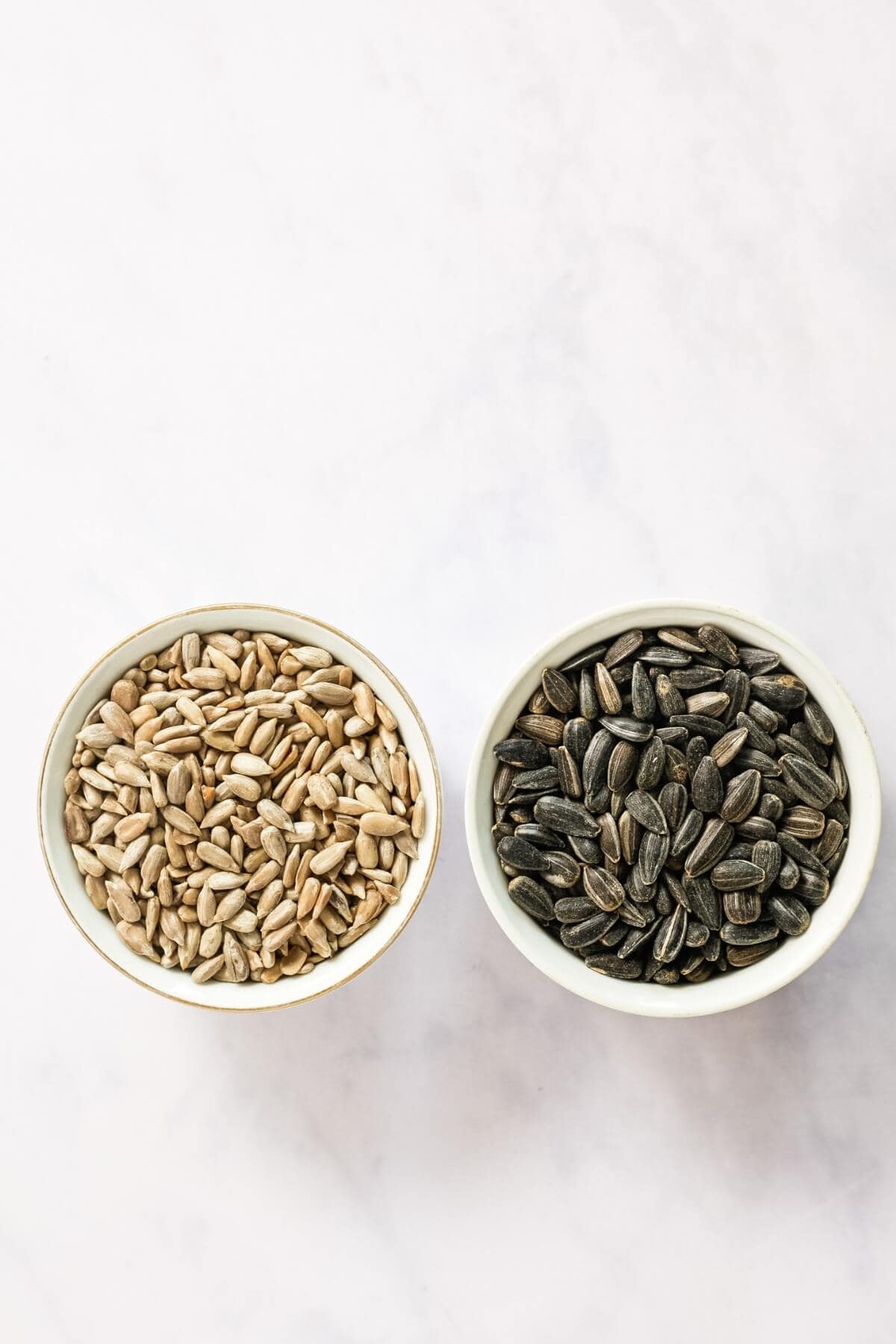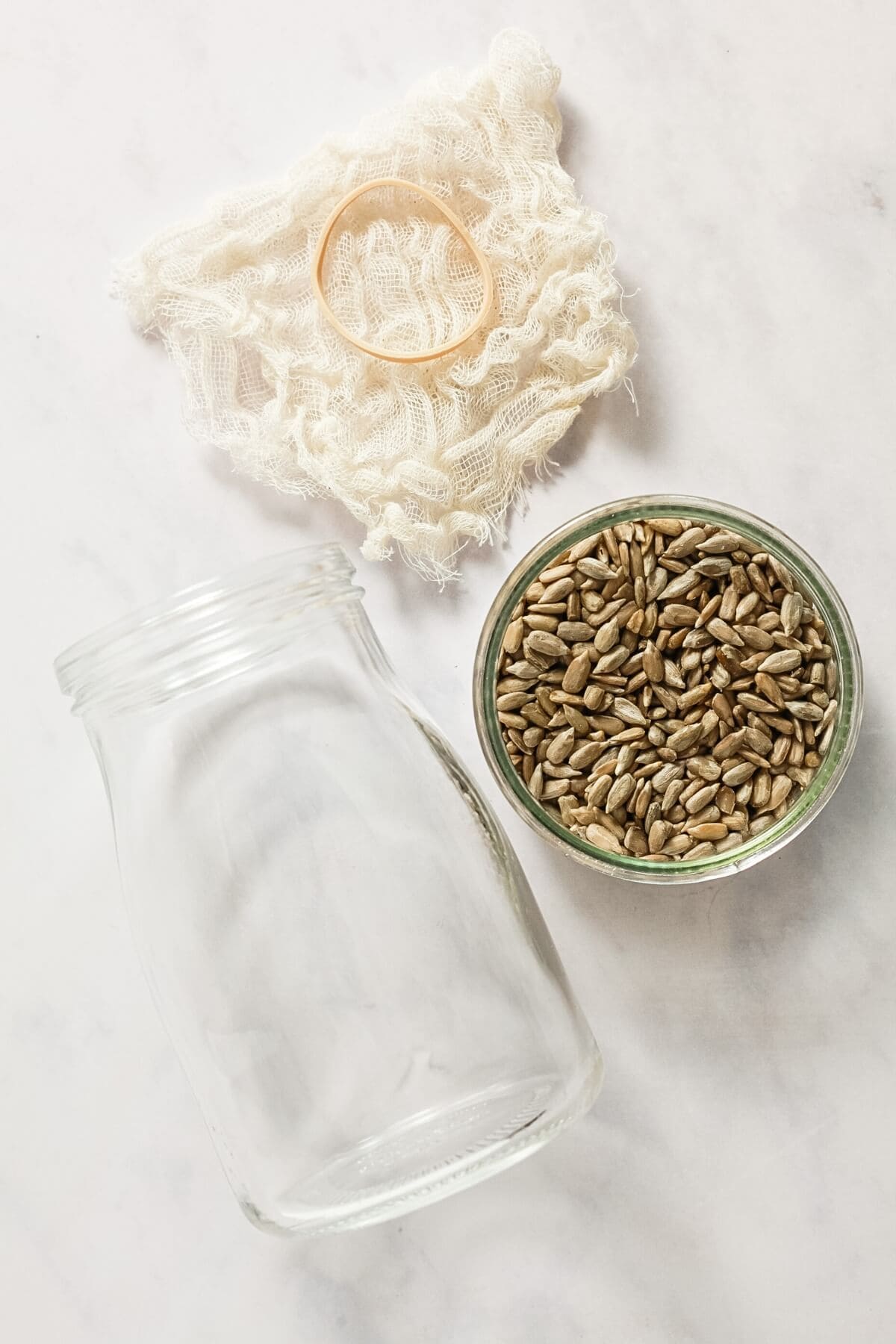Grow sunflower sprouts at home in 1-3 days and add to smoothies or blend into salad dressings, patés, sauces, raw vegan cheese, and more.
Sprouted sunflower seeds are small and tender, with a mildly nutty, earthy flavour and delightful sprinkled over salads or your morning cereal for added nutrition.

Sunflower sprouts are just sunflower seeds that you soak and allow to germinate. These can be harvested at an early stage, and enjoyed before their first leaves form. This is my preferred way to enjoy them. A little more than a soak. They're quick and versatile.
If you like to see the green leaves, those appear in about a week.
These differ from sunflower microgreens because there are no green leaves on these sprouts. If you’re looking for how to grow those longer gorgeous sunflower greens instead, (YUM!) here's my complete guide to growing sunflower microgreens.
Sprouting Series
Are you curious about sprouting? If so, then do check out my sprouting series on the blog here to get more familiar with it all.
My other current sprouting recipes include: How to grow broccoli sprouts, how to sprout quinoa, sunflower sprouts, sunflower microgreens, sprouting buckwheat, how to sprout chickpeas, sprouting adzuki beans and how to sprout lentils.
Jump to:
Are sunflower seeds good for you?
Yes, sunflower seeds are healthy and a great source of protein and fibre. They are rich in many nutrients, including vitamins C and E, calcium, iron, selenium, copper, zinc, antioxidants, polyunsaturated fatty acids and more.
If you want to read about sunflower sprouts nutrition, and a review of sunflower sprouts benefits, check out this article in the National Library of Medicine for more information.
More benefits of sunflower seeds are also shared in the book Nuts and Seeds In Health and Disease Prevention published by Elsevier Inc. 2011. To find out more visit ScienceDirect.
Ingredients
I like to use organic hulled sunflower seeds without the shell here because you don't need to spend any time removing the outer shell before eating them.
However, black sunflower seeds are great for growing sunflower microgreens!
Hulled sunflower seeds and black sunflower seeds below. The black outer shell isn't edible.

See recipe card for quantities.
Sprouting Equipment
For how to grow sunflower sprouts in jar, you’ll need the following:
- a good-sized jar or a wide-mouthed mason jar
- a muslin cloth and a rubber band / or a suitable sprouting lid
- a bowl to keep the upturned jar at an angle
- raw hulled organic sunflower seeds for eating/sprouting

Step By Step Instructions
- Soak. Add sunflower seeds to a jar and fill with fresh water. Allow the seeds to soak in preparation for germination. You can soak them for as little as 1-2 hours. I prefer to to leave them overnight (8 hours). It's little habit I’ve gotten into since I began growing sprouts and microgreens and I do this with most of my seeds. If you're unsure then, seeds which are sold for sprouting usually have recommendations on the back of their packet. Experiment and do what works best for you.
- Rinse. Rinse the seeds, and drain well. Return them to the jar and attach the lid. Place the jar at an angle into a small bowl to catch any excess water and leave it on the counter top, out of direct sunlight.
- Sprout. Depending on the room temperature, your seeds should start germinating in the next three days. Rinse and drain the seeds two to three times daily, (morning and evening works well). Your sprouted sunflower seeds are ready when a little shoot appears. Enjoy them like this, or leave them a day or two longer.
- Harvest. To harvest your sunflower sprouts, rinse and drain them before using. I like to wash them in a salad spinner so that some of the soft brown outer casings come away. They are completely edible. Some of them will float to the top and you can just scoop them up with a slotted spoon if you like and discard those. Roughly dry them on kitchen paper before using.
It's really important to drain all sprouting seeds well while they're sprouting so that they don't sit in water after their initial soaking. This is to avoid wet seeds going bad.
So, watch how they grow and give them a sniff every day (yes, really) so you become familiar with the process.

Step 1. Soak sunflower seeds overnight.

Step 2. Rinse and drain well.

Step 3. Leave to sprout in a jar and rinse/drain twice daily.

Step 4. Harvest sunflower sprouts when ready.
Storage
You can store sunflower seeds sprouts in a lidded container in the fridge. If you place them on top of kitchen paper that will soak up any excess moisture. Sunflower sprouts are best consumed on the day you harvest them or use within 2 - 3 days. Please give them a quick rinse before use.
Top tip
The sprouting sunflower seeds will change colour with flecks of brown to red even.
Place your sprouted sunflower seeds in direct sunlight on the last day and their shoots will start to turn light green. They're quite pretty and earthy loooking.
The image showing my sprouted sunflower seeds is what they look like after rinsing and pinching off the greyish outside layer, which is optional.
FAQ
As they soften, the seeds change colour speckled with brown and hints of red even. They have a pale cream coloured shoot a couple of centremeters long.
Sunflower sprouts are ready when a small shoot starts to grow from the seed. The shoots are pale in colour and grow longer each day until their first two leaves appear.
Enjoy sunflower sprouts sprinkled over cereal, salads and wraps, or use them to make creamy salad dressings, smoothies, dips, and more.
How to tell if my sprouts have gone bad
Give your sunflower sprouts a sniff. Healthy sprouts will smell fresh. If your sprouts spoil, discard them and start again.
If sunflower seed sprouts smell funky, not fresh, or look slimy then it's likely they have spoilt. Also, if you notice what appears to be like fluffy white cotton wool appearing among the seeds, throw those out too.
Related
Looking for other sprouting recipes? Try these:
📖 Recipe

Sunflower Sprouts (Step By Step)
Equipment
- 1 Glass jar or mason jar.
- 1 Piece of cheesecloth and rubber band or a sprouting lid
- 1 Strainer or sieve.
- 1 A bowl.
Ingredients
- 50 g raw hulled sunflower seeds (for sprouting)
- fresh cool water as needed (for rinsing)
Instructions
- Soak. Add your raw hulled sunflower seeds to a jar and top with plenty of water. Allow them to soak for up to 8 hours or overnight.50 g raw hulled sunflower seeds
- Rinse. Rinse the seeds then drain them well. Return the seeds to the jar and place the lid on. Turn the jar at an upturned angle and it place into a small bowl to allow any excess water to run out.fresh cool water as needed
- Sprout. Leave the jar to one side out of direct sunlight and give them time to sprout. Rinse and drain them every twelve ours (twice each day). Morning and evening works well. Depending on the room temperature they should sprout in the next three days. They sprout more quickly in warmer weather.
- Harvest. Your sprouted sunflower seeds will be ready to harvest once they have germinated and produced little shoots. Enjoy them like this or wait a few more days for them to grow a little longer. To harvest your sunflower sprouts, give them a good rinse, drain well and then leave to dry off for a few minutes on some kitchen paper or a clean kitchen towel before using or storing.




















Comments
No Comments